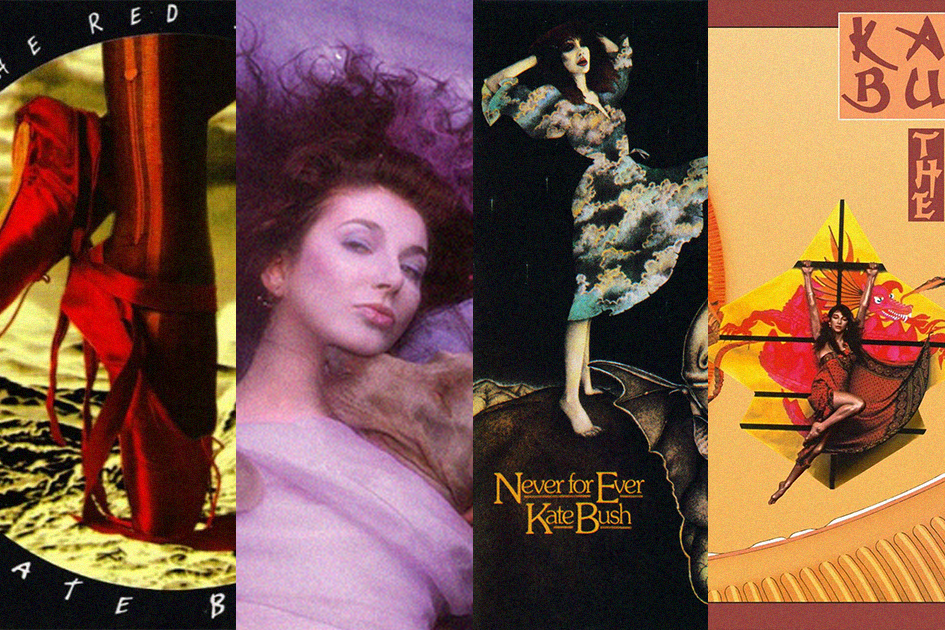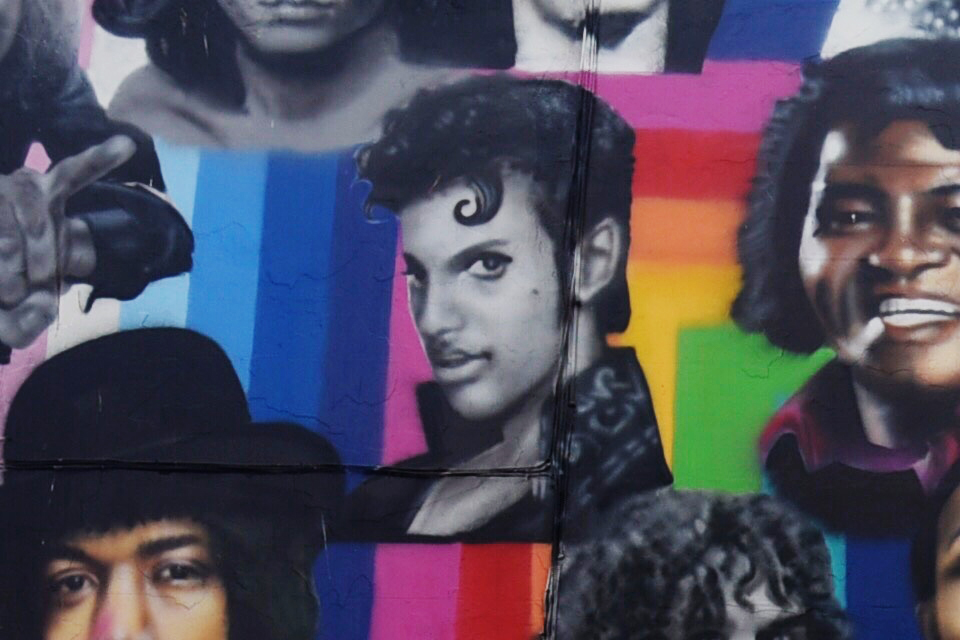As part of our Music Made Us campaign, creatives, music professionals, experts and journalists reflect on how music has been there for us through good times and tumultuous periods that inspire change. Throughout generations, music has sparked, supported and commented on movements, memories and moments in time.
Our contributors explore these events’ relationship with music – from slavery in the 1800s to the UK’s 80s acid house and rave scene and today’s Black Lives Matter movement. From her new book, You’re History: The 12 Strangest Women in Music, writer Lesley Chow takes a look at one of the greatest women in music: Kate Bush.
Kate Bush is one of music’s greatest innovators, but it’s her unerring instinct for pop that set the world on fire.
Today, Kate Bush is a genius no-one contests, but what was the strangeness of the woman’s first appearance on TV, and the even greater oddity of her success as a pop star? When, in the “Wuthering Heights” video, that figure first appeared — a slash of red in the forest, a warning flash in its eyes — it was the visual equivalent of a shriek over jarring chords. The smashing effect of that encounter has yet to be matched in popular music. Part of the mystery was the way that the initial shock eased into an insistently catchy refrain (“It’s me, I’m Ca-thy”). The segue to a hip-swinging chorus was a sign of this apparition making itself at home, treating all of its newness — its musical innovation, stark look and specific references – as a given.
For a musician known for her layered work in the studio, Kate Bush is surprisingly hummable — almost addictively so. None of the other women in my book You’re History are in danger of winning a Nobel Prize, though Bush might, and her list of high-flown muses — Joyce, Brontë, Delius — would only seal the deal. But what made this peculiar artist “universal” has more to do with her pop instincts than her sophistication.
So many of her iconic tracks, from “Running Up That Hill” (1985) and “Rubberband Girl” (1993) to “Babooshka” (1980) and “The Wedding List” (1978), are a mix of the handmade and the machine-tooled: beneath the fine lacework of these songs is a driving rock motor, the aggressive kick of popular music. It is the pairing of flash with delicacy that makes the work uncanny: the fact that these fey stories are infused with the rush of power pop. Her sensibility is inseparable from big drums, gaudy effects, and all that synth.
Bush may regret the arrangement of some of the 80s and 90s tracks — on the revisionist album Director’s Cut (2011), she strips eleven previous songs of their period stylings, going for a “warmer, fuller” tone with analogue equipment. But while the engorged sound of 80s super-production may be too much for modern tastes, it is also a part of the songs’ immediate appeal — in a word, their “wow.”
The 2011 version of “Rubberband Girl” suffers most from this deflation: the original single was arresting precisely because its deluxe sound matched the lyrical theme of impersonality. Instead of a refined treatment, the protagonist’s fragility was wedded to glam excess. “Rubberband Girl” doesn’t need warming up, any more than one would wish to “cleanse” Prince’s work of its 80s dazzle. Where would those songs be without their excitement over outdated technical wizardry, their exhausted spells?
“Running Up That Hill” is remarkable for the way its epic theme of alienation is expressed through modish pop effects, courtesy of the Fairlight synth. Rather than sounding dated, the song seems mysteriously time-bound, as if an eternal subject was making itself known through the styles and forms of one period — in this case, 80s melodrama, with its storm of agonised synth.
Bush’s most enigmatic tracks are actually some of her catchiest.
We marvel at the fact that such originality can be combined with the sure delivery of pop satisfaction: the chord progressions that give us catharsis, sometimes with the confected sadness of Japanese TV themes. Her lyrics read respectably off the page, but they are animated by startlingly aggressive hooks.
“Babooshka” is extraordinarily cool about narrating a wife’s devilish plan, using a little slip of a rhyme (“a pseudonym / to fool him”) for exposition, and then plunging into the irresistible, sing-along chorus that fires the woman’s rage. “The Wedding List” makes its tale of revenge murder almost comically accessible, especially during the coda: “And after she shot the guy / She committed suicide / And later when they analysed / They found a little one inside.” This sunny, swinging outro has us fairly dancing out the door. How natural and easy it is to pass over mere facts, carried along by the smooth line and the logic of rhyme.
The songs are particularly interesting in these “rocking” moments: listen to the use of power chords and boogie in “James and the Cold Gun” (1978), or the sax break in “The Saxophone Song” (1978) that wouldn’t be out of place in Sade. Bush’s lyrics can be so elegiac that they need the jolt of a riff. The result is a fully enclosed vision that also has the melodic drive and organisation of a hit.
It is the tension between conventionality and strangeness that makes the work so absorbing.
Bush’s greatest songs tend to be based on a desperately simple wish: to be in love and never out of it, to be made instantly wise without effort (“Sat in Your Lap”, 1981), to have a test of love end happily (“Babooshka”), and the dream of sweet anaesthesia in “Rubberband Girl” and “Running Up That Hill”. What these tracks have in common is the desire to rid oneself of complexity, to be relieved of one’s history and memory.
The narrator of ”Running Up That Hill” claims that a body swap would lead to “no problems,” and an ideal across several tracks is the serviceable “rubberband girl”, capable of endless give. The goal is to be under a happy delusion: to think less and retain nothing, from a woman who unfortunately knows all too much. But the fantasy of ignorant bliss — à la Dollhouse, Westworld or even The Handmaid’s Tale — is seductive, and there are many ways of being a vacuum.
The woman in “Rubberband Girl” wants to switch from a feeling body to a cold machine, erased of all traces and trauma. She craves obliteration, longing to be never, forever. It is one of Bush’s best and most suggestive lyrics, conveying the frantic, if insincere, yearning to be pliant and passive. If the idea is to blank out the mind and let one’s body take the hits, then the mode of dance seen in the video is the perfect solution. In the clip, Bush performs leaps and swoops under the care of a male dancer, who lifts her towards the temporary high of losing control. Dance gives one the chance to be completely elastic and yielding, then snap back in an instant. But too much rubber-banding can lead to a total loss of limits: by the end, the man sways Bush into a straitjacket.
The video for “Running Up That Hill” also looks at the ability to lose control as part of a choreography. In the arms of her male partner, Bush stretches and rises, making an “unfettered” leap under guidance — as close to elation as the song will get. In this track, a man and woman have reached that extreme point in their relationship where “a deal with God” seems like both the simplest and most audacious solution. Bush’s character proposes a swapping of souls, so that her partner might know how she experiences pain. This plan is made convincing melodically. The chorus seesaws, rapidly alternating between high and low notes (especially on “swap our places”), giving the impression of switching between two poles, two sites of perception: an implied duophony.
Released from her own personality, Bush pictures herself flying free, up to a point — little rushes of notes (“Be running up that road, be running up that hill, be running up that building”) express that projected energy, as she suddenly longs to scale impossible heights. However, when we actually hit the notes “road” and “hill,” their slight depression sends us on a frustrated dash towards the next object. Bush’s character imagines that life in a boy’s body would be magically uncomplicated: full of eager, openhearted bounding, a child-like state of having “no problems.” The grown woman knows things can’t be that simple, but she retains the image of that free run, even if the song never gets her all the way there.
Like “Rubberband Girl” and “Babooshka”, “Running Up That Hill” envisions no compromise between pain and its absence. At the outset, the narrator claims to feel nothing, although her statement sounds truncated, as in “…it doesn’t hurt me.” The following question, “Do you want to know how it feels?,” hints at both sympathy and sadism. Imagining her partner’s life to be painless, she wants him to have a taste of hurt, but for the purpose of getting them to a new level of understanding. The repeated run-ups of the chorus seem like attempts to test this program out. They are exercises in momentum, to the extent that Bush’s rhythms are often underscored by dance movement.
In the medium of dance, all of the dreams in “Running Up That Hill” can be realised: body-swapping, the mirroring of each other’s gestures, an abrupt loss of power followed by gains. A girl can turn to rubber in a man’s arms, only to regain her independence a second later. What dance also supplies is the sudden injection of energy: the kick inside the music, which is the urgency of commercial pop. This kind of lift-off — achieved melodically, or with a dance partner — is the soaring feeling of “no problems,” a vantage point that the woman compares with her own bruised life. The chorus of oscillating highs and lows suggests that there is no middle way by which these perspectives can be reconciled. The song’s vibe remains a fog of synth and abstracted human voices (“yeah, yeah, yo”), pierced by drums and the melodic line: the occasional flash of lucidity.
A concentrated spiral of a song, “Babooshka” doesn’t generalise about the nature of male and female desire — instead, it offers a single, unrepeatable case history, in which a character designs her own downfall. A Russian woman writes heated love letters to her husband under an assumed name, both hoping and fearing they’ll catch fire. The plan works only too well: the man is hooked, reading the letters with a “strange delight,” as Bush pronounces with cat-like pleasure. Arranging a meeting, the woman dresses up as her idea of an exotic temptress, but her unmasking will be the ruin of both husband and wife.
This tale of self-defeating ingenuity would be riveting purely in terms of plot — a Vertigo-like take on the way we script our own disasters with diabolical precision — but what made the song a huge hit is also what makes it mysterious: the cool roll-over of rhyme that naturalises the woman’s actions, and the infectious, shouting chorus with which the husband gladly tosses away his marriage (“All yours, babooshka, babooshka, babooshka, ya-ya!”). Although she didn’t know it at the time, Bush’s lyrics combined two words for grandmother in Russian and Greek, babushka and yaya. This coincidence only adds to the imagery. Beneath the siren’s guise is the rage of the aging woman, both thwarted and satisfied by her husband’s taking the bait. That is the song’s horror: of a granny made sexless by her own literary invention, tearing off the veil of youth and beauty.
In the video, Bush wears a mythical “Russian” costume, a mishmash of stripes, gold bikini and headdress that passes for ethnic. Like the use of the word babushka, this is a misguided appropriation that works. Throughout her career, Bush has seized on exciting fragments out of context: she famously wrote “Wuthering Heights” (1978) after seeing the tail-end of a TV miniseries rather than finishing the book, and became attracted to the idea of Delius after watching the Ken Russell biopic. In this case, she chose babushka irrespective of its meaning, hearing a latent whoosh and fire — and even her own name — in the word, and extrapolated her narrative from there.
The economy with which Bush narrates bizarre events — the triple killing in “The Wedding List”, the tiny rhyme containing the seeds of tragedy in “Babooshka” — is part of their enduring fascination. On the title track of her 2011 album, she engages our emotions — if not our understanding — with the impossibly specific cry, “Let me hear your 50 words for snow!” Her best work will always be maddeningly particular and, just as importantly, catchy. Along with her prized visual imagination, she has the underrated ability to give feeling and comfort on demand: to pace us through a wildly original song with a series of rest stops (“Wuthering Heights”); to soothe and unnerve with the yearning line of a chorus (“Mother Stands for Comfort”, 1985); to defy melodic expectations and keep that disappointment ringing in our ears (“Running Up That Hill”).
That knack of catching and releasing our instincts is what enabled Bush’s songs to travel, no matter how obscure their subject. As with Bowie and Morrissey, her way with hooks is a weirdly essential part of her work, tying mystery to the compulsiveness of dance. Kate Bush’s songs may be ethereal, haunting, and all those other adjectives applied to female artists, but above all, they are immediate. Their urgency takes strangeness for granted.
Lesley Chow’s book, You’re History: The 12 Strangest Women in Music, featuring Kate Bush, Neneh Cherry, Janet Jackson, Chaka Khan and other groundbreaking female artists, is released by Repeater on March 8. Keep up-to-date with Lesley via her Twitter, here. Buy the book today: UK paperback // UK Kindle



